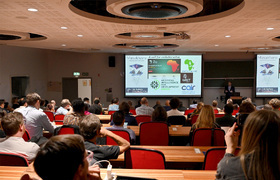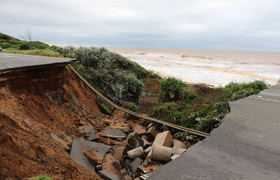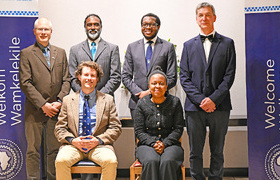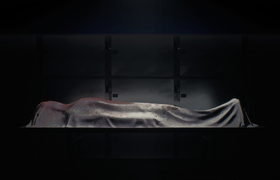UCT and IDIA unveil groundbreaking VR software
03 October 2024 | Story Thami Nkwanyane. Photo Supplied. Read time 4 min.
The University of Cape Town’s (UCT) Department of Astronomy and the Inter-University Institute for Data Intensive Astronomy (IDIA) – a partnership between UCT, the University of the Western Cape and the University of Pretoria – have released new innovative virtual reality (VR) software.
The release of the immersive Data Visualisation Interactive Explorer (iDaVIE) software by the IDIA Visualisation Lab (IDIA Vislab) marks an important milestone and significant advancement in astronomy data visualisation and analysis, offering researchers a powerful tool to enhance their work using VR.
iDaVIE has been developed by the IDIA Vislab in collaboration with the Astrophysical Observatory of Catania of the Italian National Institute for Astrophysics (INAF-OACT). It is designed to facilitate the visualisation and interrogation of complex astronomical and multidisciplinary datasets, exploiting the unique capabilities of VR.
“This software represents years of hard work, and we believe it will be a valuable resource for researchers around the world.”
Dr Lucia Marchetti, from UCT’s Department of Astronomy and the director of the IDIA Vislab, expressed her excitement about the release: “We are thrilled to make iDaVIE available to the public. This software represents years of hard work, and we believe it will be a valuable resource for researchers around the world as already proven by the many publications that have used iDaVIE while still under development.”
The software is particularly beneficial for the astronomy community, enabling the analysis in unprecedented detail of 3D data cubes and catalogues like those produced by MeerKAT and, eventually, the Square Kilometre Array (SKA).
Key features
The key features of iDaVIE include:
- Interactive and immersive visualisation: It allows users to use easily accessible commercial VR headsets to immerse themselves in and interact with the data in real time, providing a more intuitive understanding of complex datasets.
- Scalability: It’s capable of handling different types of data input, making it suitable for a wide range of scientific research beyond astronomy, eg engineering and medical/biology research. See some multi-disciplinary examples reported.
- Open source: The release of the source code encourages collaboration and further development by the global research community.
Professor Patrick Woudt, professor of astronomy and the interim director of IDIA, added: “iDaVIE aligns with IDIA’s commitment to advancing data-intensive research and fostering innovation in South Africa. We are very happy to release this to the community and we look forward to the next developments that will follow.”
Supporting global research
By making the software and its source code freely available, UCT and the IDIA Vislab aim to support the global research community and encourage the development of new tools and techniques in data visualisation, while hoping to foster new global collaborations in this field.
Dr Marchetti also shared a message honouring her predecessor and IDIA Vislab founding director, Professor Tom Jarrett, who passed away in July 2024: “The entire IDIA Vislab team and I would like to dedicate this release to our late director, mentor and friend, Tom, who sadly passed away too soon, before this important milestone that he initiated and to which he contributed for many years could be announced. He would have cherished this release with us today.”
For more information about iDaVIE and to access the software and source code, please visit iDaVIE documentation online.
 This work is licensed under a Creative Commons Attribution-NoDerivatives 4.0 International License.
This work is licensed under a Creative Commons Attribution-NoDerivatives 4.0 International License.
Please view the republishing articles page for more information.
Research & innovation






























.jpg)






